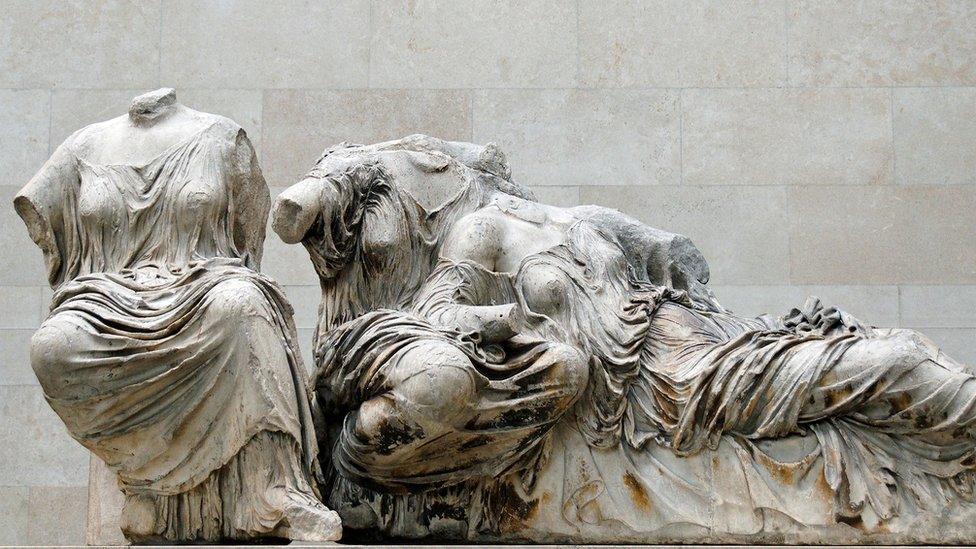Elgin Marbles: Why are people saying this art was 'stolen' by the UK?
- Published
- comments

The Parthenon Marbles are one of the British Museum's biggest attractions - but some argue that they do not have the right to display them
Millions of people visit museums in the UK every year to get a chance to see wonderful pieces of historic art up close.
But some of the pieces currently on display in British museums have controversial stories behind how they were brought to the UK.
One of the most famous examples of this are the Parthenon Marbles, also sometimes called the Elgin Marbles.
Lots of people, including Greek Prime Minister Kyriakos Mitsotakis, have been asking for the art to be returned to Greece, where it originally came from.
Mr Mitsotakis even offered last week to loan other treasures to the British Museum in exchange for it finally returning the Parthenon Marbles back to Greece.
You can read about the arguments in this article, have your say in our vote on what you think should happen and also leave us a comment too.
What are the Parthenon Marbles?
Britain looked to expand their power in the 19th century by taking over foreign countries, this is called colonisation.
In the 19th century (1801-1899) rich and technologically advanced countries like Britain, France and Portugal wanted to expand their empires by invading other countries and taking control of their resources. This is called colonialism.
Many Britons saw their presence in other countries as a positive thing - they thought it was helping their economy and that the countries would benefit from adopting British customs.
It was during this time that hundreds of marbles from the Parthenon - a famous Greek temple built nearly 2,500 years ago in Athens - were taken by a British man named Lord Elgin.
AC Milan fans, during a 2007 game with Liverpool, hold up a banner asking why the Parthenon Marbles have not been returned to Greece
But many people remain shocked at the way the marbles were taken and say that in simply taking treasures from other places, countries like Britain abused their power.
They argue that the marbles were not lawfully given to Lord Elgin, and that they should be returned to the Parthenon in Greece.
If you can't see this vote, click here.
What are the arguments for keeping the art?
This piece of art, showing five girls walking in single file, is part of The Parthenon Marbles - a collection of stone objects, inscriptions and sculptures, also known as the Elgin Marbles
British museums which display art taken during the colonial era argue that there are good reasons for keeping many of these works in the UK.
They say that the art is well protected and cared for in British museums, and that these pieces allow people to appreciate works of countries and cultures they might not ever have been able to experience.
Some say the stories behind the art are part of the display, and former colonial countries should not hide from their history.
Furthermore, some argue that if every country claimed their works of art back, there would be very few things left to see in the museums.
What are the arguments for returning the art?
The Elgin Marbles are one of the British Museum's most popular exhibits in London
There is not much evidence that the art was taken with permission.
Some would argue the right thing to do is to return the art from where it was taken - that it belongs to the people of Greece.
They also suggest that there is more value in seeing the art in the countries in which it was made.
Last week, Greek Prime Minister Kyriakos Mitsotakis once again put forward his offer that Greece could loan other treasures to the British Museum to display in return for the "stolen" Parthenon marbles being sent back to Athens.
Should the pieces of art be returned? You decide!
Do you think it is right for Britain to continue to keep the art in our museums, or should they be returned to the places they came from?
Click here to take part in our vote.
Click below to find out the stories behind the museum pieces and comment below with your thoughts.
